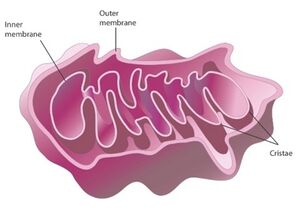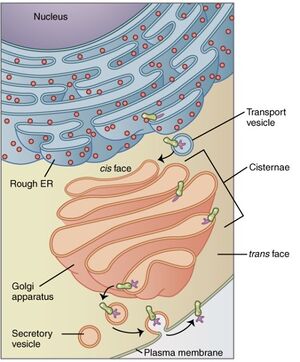Membranous cell organelles - structure and function
Membranous Cell organelles – structure and function
1. Mitochondria
Elongated structure 0.5-1 µm in diameter and lengths up to 20µm.
Double membrane-bound organelle found in most eukaryotic cells. Mitochondria have been described as "the powerhouse of the cell" – ATP production.
In addition to supplying cellular energy, mitochondria are involved in other tasks:
• signaling
• cellular differentiation cell death,
• maintaining control of the cell cycle and cell growth
• Calcium storage, oxidation of fatty acids.
• Endosymbiotic theory - The fact that mitochondria have certain bacterial characteristics has led to the hypothesis that mitochondria originated from an ancestral aerobic prokaryote.
Within the mitochondrial matrix resides a compact circular chromosome of DNA, along with ribosomes facilitating limited proteosynthesis, mRNA, and transfer RNA. Protein synthesis takes place within the mitochondria. Notably, the mitochondrial genome encodes only a portion of mitochondrial proteins. These proteins possess a short amino acid sequence serving as a signal for their transport across the mitochondrial membrane, facilitated by translocases.
• The Chemiosmotic process, as a theory, pertains to the production of ATP through the movement of hydrogen ions across a membrane during cellular respiration. Protons, also known as hydrogen ions, diffuse from regions of high proton concentration to those of lower proton concentration. This establishment of an electrochemical concentration gradient of protons across a membrane is utilized to generate ATP.
Mitochondria traverse the cytoplasm via microtubules, and the quantity of mitochondria within a cell correlates with its energy demands. Both mitochondrial membranes host a plethora of proteins and exhibit reduced fluidity. The outer membrane features numerous transmembrane proteins known as porins, which form channels facilitating the passage of small molecules from the cytoplasm into the intermembrane space. Conversely, the inner membrane is intricately folded, forming elongated structures called cristae that significantly augment the membrane's surface area. The abundance of cristae also aligns with the cell's energy requirements.
Integral proteins embedded in the impermeable lipid bilayer confer selective permeability to the inner membrane, allowing only small molecules necessary for ATP synthesis to pass through. Matrix enzymes include those responsible for oxidizing pyruvate and fatty acids to generate acetyl CoA, as well as those involved in the citric acid cycle, which oxidizes acetyl CoA, liberating CO2 as a waste product. Additionally, these enzymes produce small, energy-rich molecules that furnish electrons for the electron transport chain (respiratory chain).
2. Rough and Smooth Endoplasmic Reticulum
The rough endoplasmic reticulum (RER) is highly pronounced in cells specialized for protein secretion. It comprises sac-like cisternae enclosed by membranes that extend continuously from the outer membrane of the nuclear envelope. The surface of the RER is densely populated with ribosomes engaged in protein synthesis, imparting it with a rough appearance.
Despite the absence of a continuous membrane between the endoplasmic reticulum and the Golgi apparatus, membrane-bound vesicles facilitate the transport of proteins between these two compartments.
RER manufactures of lysosomal enzymes, secreted proteins, integral membrane proteins.
SER (smooth endoplasmic reticulum) lack bound polyribosomes, and in most cells is less abundant that RER.
The roles of the SER are:
• The synthesis of various phospholipid molecules constituting cellular membranes occurs either directly within the membrane by vesicles or through phospholipid transfer proteins.
• Smooth endoplasmic reticulum (SER) occupies a significant portion of the cytoplasm in cells engaged in synthesizing steroid hormones, such as those found in the adrenal cortex. It contains some of the enzymes necessary for steroid synthesis.
• Detoxification of drugs and toxins is another role of the SER, which is abundant in liver cells. Here, it houses enzymes responsible for processes like oxidation, conjugation, and methylation, which degrade certain hormones and neutralize harmful substances.
• Additionally, the SER serves to store and release calcium in a controlled manner, playing a crucial role in the rapid cellular response to various external stimuli. This function is particularly well-developed in muscle cells, where the SER participates in the contraction process and adopts a specialized form known as the sarcoplasmic reticulum.
3. Golgi Appartus:
The Golgi apparatus plays a crucial role in packaging proteins into membrane-bound vesicles within the cell before dispatching them to their designated destinations.
It holds particular significance in processing proteins for secretion, housing a set of glycosylation enzymes responsible for attaching various sugar monomers to proteins as they traverse through the apparatus.
Structurally, it comprises two primary networks: the cis Golgi network (CGN) and the trans Golgi network (TGN). The CGN consists of fused, flattened membrane-enclosed disks called cisternae, which are further subdivided into cis, medial, and trans compartments. The TGN serves as the ultimate cisternal structure, from which proteins are packaged into vesicles bound for lysosomes, secretory vesicles, or the cell surface.
Functionally, the Golgi apparatus serves as a pivotal hub for collecting and dispatching protein products received from the endoplasmic reticulum (ER). Proteins synthesized in the ER are encapsulated into vesicles that subsequently merge with the Golgi apparatus. Here, these cargo proteins undergo modifications and are then directed for secretion via exocytosis or for utilization within the cell. In analogy to a post office, the Golgi apparatus packages and labels items before distributing them to various parts of the cell or to the extracellular space. Additionally, the Golgi apparatus is involved in lipid transport and the formation of lysosomes.
4. Lysosomes:
Lysosomes are cellular organelles housing acid hydrolase enzymes responsible for breaking down waste materials and cellular debris, earning them the designation of the cell's "stomach."
Lysosomes facilitate the digestion of surplus or worn-out organelles, food particles, and engulfed viruses or bacteria. The lysosomal membrane provides an environment conducive to the optimal functioning of the digestive enzymes by maintaining an acidic pH of approximately 4.8 within the lysosome, contrasting with the slightly basic cytosol with a pH of around 7.2.
By encapsulating these degradative enzymes within their membrane, lysosomes shield the cytosol and consequently the entire cell from their potentially harmful effects. Additionally, the lysosomal acid hydrolases are pH-sensitive and exhibit diminished or no activity in the alkaline environment of the cytosol, preventing destruction of cytosolic molecules and organelles in case of enzyme leakage from the lysosome.
5. Peroxisomes:
Peroxisomes are spherical, membrane-bound organelles typically measuring approximately 0.5µm in diameter. They house enzymes involved in lipid metabolism and catalyze the oxidation of specific organic substrates by removing hydrogen atoms, which are subsequently transferred to molecular oxygen.
Abundant in liver and kidney cells, peroxisomes owe their prevalence to the catalase enzyme, present in all peroxisomes, which facilitates the detoxification of ethanol.
6. Melanosomes:
Melanosomes are cellular organelles containing the pigment melanin, derived from the amino acid tyrosine, and serve as protection against ultraviolet (UV) radiation.


